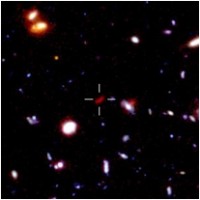Reinvigorated Hubble reveals most distant galaxies yet

Galaxies which are likely to be the most distant yet seen have been identified by two teams of UK astronomers using the recently updated Hubble Space Telescope (HST).
The UK teams, one led by Andrew Bunker and Stephen Wilkins at the University of Oxford and the other by Ross McLure and Jim Dunlop at the University of Edinburgh, analysed infrared images from the new Wide Field Camera 3 (WFC3) instrument on HST, installed during the most recent Space Shuttle servicing mission in May 2009.
Infrared light is light invisible to the human eye, with wavelengths about twice as long as visible light – beyond those of red light.
"The expansion of the Universe causes the light from very distant galaxies to appear redder, so having a new camera on Hubble which is very sensitive in the infrared means we can identify galaxies at much greater distances than was previously possible," said Stephen Wilkins, a postdoctoral researcher in astrophysics at Oxford University.
In a series of papers, to appear in the Monthly Notices of the Royal Astronomical Society, the UK teams present their analysis of the most sensitive images of the Universe yet taken in the infrared.
"The unique infrared sensitivity of Wide Field Camera 3 means that these are the best images yet for providing detailed information about the first galaxies as they formed in the early Universe", said Dr Ross McLure of the Institute for Astronomy in Edinburgh.
The new images from Hubble include the region of sky known as the Hubble Ultra Deep Field, which Bunker and colleagues were the first to analyse five years ago using visible light images taken with Hubble's Advanced Camera for Surveys (ACS).
"Hubble has now revisited the Ultra Deep Field which we first studied five years ago, taking infrared images which are more sensitive than anything obtained before. We can now look even further back in time, identifying galaxies when the Universe was only five per cent of its current age – within 1 billion years of the Big Bang," said Dr Daniel Stark, a postdoctoral researcher at the Institute of Astronomy in Cambridge who was involved in the work of both UK teams.
As well as identifying potentially the most distant objects yet, these new HST observations present an intriguing puzzle.
"We know the gas between galaxies in the Universe was ionised (where electrons are removed from their host atomic nuclei) early in the history of the cosmos, but the total light from these new galaxies may not be sufficient to achieve this," said Andrew Bunker, a researcher at the University of Oxford.
The researchers are now looking forward to seeing these intriguing objects more clearly in the years ahead.
"These new observations from HST are likely to be the most sensitive images Hubble will ever take, but the very distant galaxies we have now discovered will be studied in detail by Hubble's successor, the James Webb Space Telescope, which will be launched in 2014," commented Professor Jim Dunlop at the University of Edinburgh.
Further Information
The results are included in three separate papers in the journal Monthly Notices of the Royal Astronomical Society:
R.J. McLure, J.S. Dunlop, M. Cirasuolo, A.M. Koekemoer, E. Sabbi, D.P. Stark, T.A. Targett, R.S. Ellis, Accepted in the Monthly Notices of the Royal Astronomy Society.
Stephen M. Wilkins, Andrew J. Bunker, Richard S. Ellis, Daniel Stark, Elizabeth R. Stanway, Kuenley Chiu, Silvio Lorenzoni, Matt J. Jarvis, Accepted in the Monthly Notices of the Royal Astronomy Society.
Bunker, Andrew; Wilkins, Stephen; Ellis, Richard; Stark, Daniel; Lorenzoni, Silvio; Chiu, Kuenley; Lacy, Mark; Jarvis, Matt; Hickey, Samantha, Submitted to the Monthly Notices of the Royal Astronomy Society.

